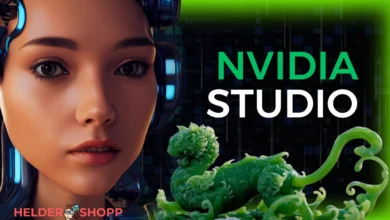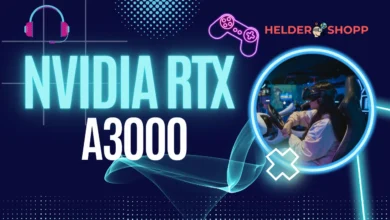NVIDIA 5000: The Next-Gen GPU for Gen AI, Content Creation, and Data Science
NVIDIA is a leading company in the field of graphics processing units (GPUs), which are specialized hardware devices that can perform complex calculations for rendering graphics, simulating physics, and running artificial intelligence (AI) algorithms. NVIDIA’s GPUs are widely used by gamers, designers, engineers, researchers, and professionals who need high-performance computing for their work.
One of the latest products from NVIDIA is the RTX 5000 Ada Generation GPU, which is powered by the NVIDIA Ada Lovelace architecture. This GPU is designed to handle the demanding workloads of today’s industries, such as generative AI, content creation, and data science.
In this article, we will explore the features, benefits, and use cases of the RTX 5000 GPU, and see how it can help you take your work to new heights.

What is the NVIDIA Ada Lovelace Architecture?
The NVIDIA Ada Lovelace architecture is the next-generation GPU architecture from NVIDIA, named after Ada Lovelace, who is considered to be the first computer programmer. The Ada Lovelace architecture introduces several innovations and improvements over the previous generation, such as:
- NVIDIA Ada Lovelace Architecture-Based CUDA Cores: These are the basic units of computation on the GPU, which can perform single-precision floating-point (FP32) operations, such as adding, multiplying, or dividing numbers. The RTX 5000 GPU has 12,800 CUDA cores, which can deliver up to 2X the speed of the previous generation for graphics and simulation workflows, such as complex 3D computer-aided design (CAD) and computer-aided engineering (CAE).
- Third-Generation RT Cores: These are specialized units of computation on the GPU, which can perform ray tracing, which is a technique for simulating realistic lighting and shadows in 3D scenes. The RTX 5000 GPU has 100 RT cores, which can deliver over 2X the throughput over the previous generation, enabling massive speedups for workloads like photorealistic rendering of movie content, architectural design evaluations, and virtual prototyping of product designs.
- Fourth-Generation Tensor Cores: These are specialized units of computation on the GPU, which can perform tensor operations, which are essential for running AI algorithms, such as deep learning. The RTX 5000 GPU has 400 Tensor cores, which can deliver up to 4X the AI compute performance of the previous generation. These Tensor cores support acceleration of the FP8 precision data type, which is a new format that can store more information in less space, and provide independent floating-point and integer data paths, which can speed up execution of mixed floating-point and integer calculations.
- 32GB of GPU Memory: This is the amount of memory that the GPU can access to store and process data. The RTX 5000 GPU has 32GB of GDDR6 memory, which gives data scientists, engineers, and creative professionals the GPU memory needed to work with large datasets and workloads, such as rendering, data analytics, and simulation.
- AV1 Encoders: These are dedicated hardware encoders on the GPU, which can compress and encode video streams, such as for streaming, broadcasting, and video conferencing. The RTX 5000 GPU supports the AV1 encoding format, which is a new standard that is 40% more efficient than the H.264 format, allowing users streaming at 1080p to increase their resolution to 1440p while running at the same bitrate and quality.
More:
What are the Benefits of the RTX 5000 GPU?
The RTX 5000 GPU offers several benefits for different types of users and applications, such as:
- For Gen AI Users: Gen AI is a term that refers to the use of AI to generate new content, such as images, videos, text, music, and more. The RTX 5000 GPU is ideal for gen AI users, as it can leverage the power of the NVIDIA Ada Lovelace architecture, the NVIDIA RTX platform, and the NVIDIA Studio software stack, to enable breakthroughs in generative AI, such as:
- StyleGAN3: This is a state-of-the-art generative adversarial network (GAN) that can create photorealistic images of faces, animals, landscapes, and more, based on a given style or attribute. The RTX 5000 GPU can run StyleGAN3 up to 4X faster than the previous generation, allowing gen AI users to explore new possibilities and create stunning content.
- NVIDIA Omniverse: This is a platform that allows gen AI users to create, collaborate, and simulate 3D worlds in real time, using the power of ray tracing, physics, and AI. The RTX 5000 GPU can run NVIDIA Omniverse with high performance and quality, enabling gen AI users to build immersive and interactive experiences.
- NVIDIA Canvas: This is a tool that allows gen AI users to paint realistic landscapes with AI, using a simple brush interface. The RTX 5000 GPU can run NVIDIA Canvas with fast and fluid responsiveness, allowing gen AI users to unleash their creativity and transform their sketches into stunning scenes.
- For Content Creation Users: Content creation is a term that refers to the process of creating digital media, such as graphics, animations, videos, podcasts, and more. The RTX 5000 GPU is ideal for content creation users, as it can leverage the power of the NVIDIA Ada Lovelace architecture, the NVIDIA RTX platform, and the NVIDIA Studio software stack, to enable faster and better content creation, such as:
- Adobe Photoshop: This is a popular software for editing and enhancing images, such as for photo retouching, graphic design, and digital art. The RTX 5000 GPU can run Adobe Photoshop with up to 2X the performance of the previous generation, allowing content creation users to work with larger and more complex images, apply filters and effects faster, and use AI-powered features, such as Neural Filters, Super Resolution, and Sky Replacement.
- Adobe Premiere Pro: This is a popular software for editing and producing videos, such as for film, TV, and web. The RTX 5000 GPU can run Adobe Premiere Pro with up to 2X the performance of the previous generation, allowing content creation users to work with higher resolutions and frame rates, apply transitions and effects faster, and use AI-powered features, such as Auto Reframe, Scene Edit Detection, and Speech to Text.
- Autodesk Maya: This is a popular software for creating and animating 3D models, such as for games, movies, and TV. The RTX 5000 GPU can run Autodesk Maya with up to 2X the performance of the previous generation, allowing content creation users to work with more complex and detailed models, render scenes faster, and use AI-powered features, such as NVIDIA OptiX Denoiser, NVIDIA RTXGI, and NVIDIA MDL.
- For Data Science Users: Data science is a term that refers to the process of extracting insights and knowledge from data, such as for business, research, and education. The RTX 5000 GPU is ideal for data science users, as it can leverage the power of the NVIDIA Ada Lovelace architecture, the NVIDIA RTX platform, and the NVIDIA RAPIDS software stack, to enable faster and better data science, such as:
- Data Preparation: This is the process of cleaning, transforming, and organizing data, such as for analysis, visualization, and modeling. The RTX 5000 GPU can run data preparation tasks with up to 4X the performance of the previous generation, allowing data science users to work with larger and more diverse datasets, apply complex operations faster, and use AI-powered features, such as NVIDIA NVTabular, NVIDIA cuDF, and NVIDIA cuML.
- Data Analysis: This is the process of exploring, interpreting, and communicating data, such as for finding patterns, trends, and correlations. The RTX 5000 GPU can run data analysis tasks with up to 4X the performance of the previous generation, allowing data science users to work with higher dimensions and resolutions, apply statistical and mathematical functions faster, and use AI-powered features, such as NVIDIA cuGraph, NVIDIA cuSpatial, and NVIDIA cuXfilter.
- Data Modeling: This is the process of building and testing predictive and prescriptive models, such as for forecasting, optimization, and recommendation. The RTX 5000 GPU can run data modeling tasks with up to 4X the performance of the previous generation, allowing data science users to work with more complex and accurate models, apply machine learning and deep learning algorithms faster, and use AI-powered features, such as NVIDIA cuDNN, NVIDIA TensorRT, and NVIDIA Triton Inference Server.

How to Get Started with the RTX 5000 GPU?
If you are interested in getting started with the RTX 5000 GPU, there are several ways to do so, such as:
- Buy a Laptop Workstation: You can buy a laptop workstation that is equipped with the RTX 5000 GPU, such as the HP ZBook Fury 17 G7, the Dell Precision 7750, or the Lenovo ThinkPad P17.
- Buy a Desktop GPU: You can buy a desktop GPU that is the RTX 5000 GPU, such as the NVIDIA Quadro RTX 5000, and install it in your existing desktop PC, as long as it meets the minimum requirements, such as having a PCIe 3.0 x16 slot, a 650W power supply, and enough space and cooling.
- Use a Cloud Service: You can use a cloud service that offers the RTX 5000 GPU, such as the NVIDIA GPU Cloud (NGC), the Amazon Web Services (AWS), or the Microsoft Azure. This way, you can access the RTX 5000 GPU from any device, anywhere, anytime, and pay only for what you use.
Conclusion
The RTX 5000 GPU is a powerful and versatile GPU that can handle the most demanding workloads of today’s industries, such as gen AI, content creation, and data science. It is based on the NVIDIA Ada Lovelace architecture, which introduces several innovations and improvements over the previous generation, such as more CUDA cores, RT cores, Tensor cores, GPU memory, and AV1 encoders.
The RTX 5000 GPU also supports the NVIDIA RTX platform, and the NVIDIA Studio and RAPIDS software stacks, which provide a comprehensive and optimized solution for different types of users and applications.
If you are interested in getting started with the RTX 5000 GPU, you can buy a desktop workstation, a laptop workstation, a desktop GPU, or use a cloud service that offers the RTX 5000 GPU. The RTX 5000 GPU is the next-gen GPU for gen AI, content creation, and data science, and it can help you take your work to new heights.




